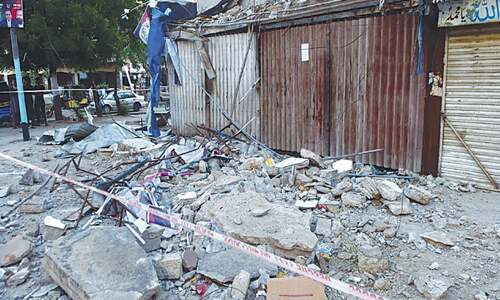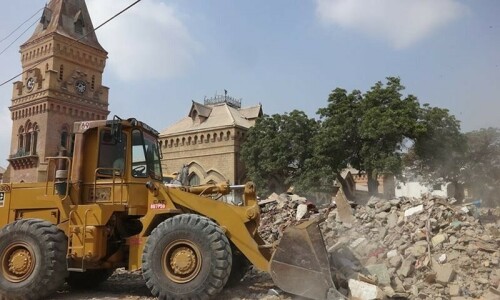
KARACHI: Gulab Shah, 45, is having sleepless nights. He and his family are worried about their imminent migration from their village in Jhaloo to a major city, thanks to the continued ingress of seawater inland.
“That is all that I and my brothers discuss day and night,” he told IPS over telephone from his village that lies near Kharo Chhan, in Thatta district.
He and his family also talk about what it “will mean living among strangers, in a strange place; adopting an unfamiliar lifestyle; losing culture and identity”.
Of the nearly 6,000 acres of land that Shah’s father inherited, over 2,500 acres have slowly been swallowed by the sea over the last 70 years. And even though they still have enough land to sell to enable them to set up their home in a city, “there are no buyers!” Shah proclaimed.
“Nobody wants to buy land that they know is going to be submerged soon,” he said.
And if they stay, they do not have enough farmhands to work on their land. “Every year more and more people, mostly farmhands, are moving out of here as there is less work for them,” Shah explained.
For millions of years, the River Indus sustained the marshes, the 17 creeks, miles of swamps, mangrove forests and the mudflats along with the various estuarine habitats in the fan-shaped Indus delta, before reaching its final destination and emptying into the Arabian Sea. It marks a journey of 3,000 km from the Himalayas.
Today this Ramsar site, a wetland of international importance, is parched and dying a slow death.
The dams and barrages on the river sucked the fresh water and stopped it from reaching the delta. It also resulted in a reduction of sediment deposition, giving the sea a perfect opportunity to ingress into the land.
Climate change has had an impact too here. The rains are unpredictable now, water levels don’t increase and conversely over the years there has been an increased demand for water for both agricultural activities and a growing population.
If the delta gets 10 million acre feet (MAF) consistently over 12 months, or 5,000 cubic feet per second daily, as promised through the Water Apportionment Accord of 1991, the delta would thrive. However, that is not the case. “Along the way, from the mountains to the sea, there is shortage, pilferage coupled with losses due to an ageing distribution system,” explained Usman Tanveer, the deputy commissioner of Thatta.
“We require a well-regulated water management system from the time the water leaves the mountains till it reaches the Arabian Sea,” he said.
He pointed out that as a specialised subject, water needs to be looked into more scientifically. For example, said Tanveer, “first and foremost, we need proper research and experts to be able to plan for future water needs and this includes coming up with finding optimal conservation solutions, natural sites if small dams have to be built (instead of frowning upon whenever the D [dam] word is brought up).”
A 2018 report by the United States-Pakistan Centre for Advanced Studies in Water (USPCASW) at Mehran University of Engineering and Technology (MUET), Jamshoro, using historical maps and field research, noted that back in 1833 the delta spanned some 12,900 square kilometres; today it was a mere 1,000 square kilometres.
“The human impact on the environment, the change in the natural flow of the river, resulting in reduction in sediment deposition, and sea-level ingress and climate change have resulted in the contraction of the delta,” said Dr Altaf Ali Siyal, who heads the Integrated Water Resources Management Department (IWRM) at USPCASW, and is the principal author of the delta report. The study concludes the delta today constitutes just eight to 10 per cent of its original expanse.
But many living in the delta believed it would begin to die when man reined in the mighty Indus. The construction of the Sukkur Barrage (1923 to 1932) by the British, followed by Kotri Barrage in 1955 and Guddu in 1962, squeezed the life out of the once-verdant delta.
Prior to this, Sindh used to receive 150 MAF of water annually, now it is around 10 MAF annually. “It would be even better if it receives between 25 and 35 MAF water so that it can return to its past grandeur,” Siyal said.
But Dr Hassan Abbas, an expert in hydrology and water resources, has both long- and short-term solutions to revive the delta.
“One would be to rejuvenate the natural course of the river the way United Kingdom, the United States and even Australia are doing by dismantling dams and adopting the free-flowing river model,” he said.
“A free-flowing model is one where water, silt and other natural materials can move along unobstructed. But more importantly, it’s one by which the ecological integrity of the entire river system is maintained as a whole,” explained Dr Abbas.
The other, more imminent, solution is to address the way farmers irrigate. “We need to make agriculture water-efficient without compromising on our yield. The water saved thus can be allowed to flow back into its course and regenerate the delta.”
However, a quick and cost-effective manner of addressing water shortage in cities like Karachi, said Abbas, was through exploiting the riverine corridors of active floodplains.
“The Indus has 6.5km of floodplain on either side which has sweet sand under which is the cleanest mineral water you can get. Most of the big cities are not more than 3km away from the riverbed. All that needs to be done is to pump that water up from the depth of 300 to 400 feet using, say solar energy and supply it to the cities through pipes,” explained the hydrologist.
But what about the Shah’s village in the delta? “It is far, about 200km from the river,” agreed Abbas, conceding the people in the delta urgently needed to be supplied with drinking water.
“It would require a much longer pipeline, but would still be cheaper to transport the same water that way,” he said.
Published in Dawn, August 23rd, 2019














































